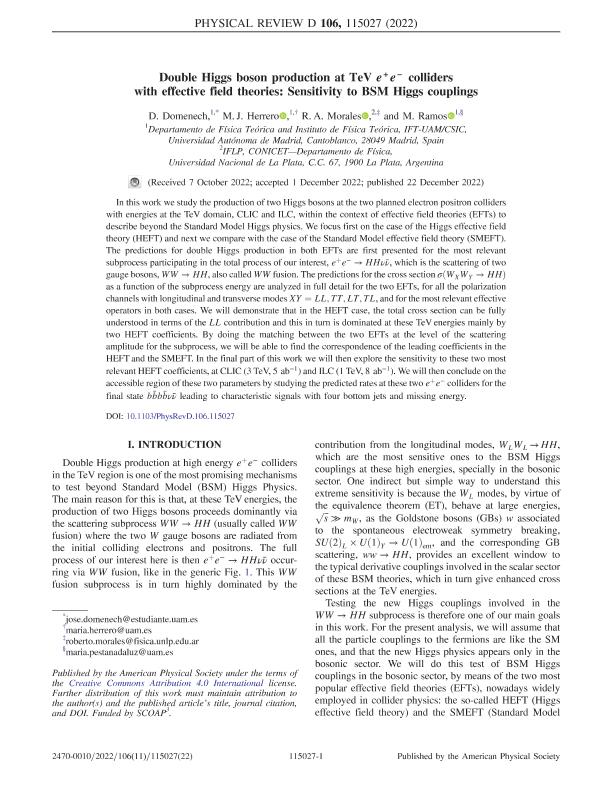Mostrar el registro sencillo del ítem
dc.contributor.author
Domenech, D.
dc.contributor.author
Herrero, Maria J.
dc.contributor.author
Morales, Roberto Anibal

dc.contributor.author
Ramos, M.
dc.date.available
2023-08-28T14:05:20Z
dc.date.issued
2022-12
dc.identifier.citation
Domenech, D.; Herrero, Maria J.; Morales, Roberto Anibal; Ramos, M.; Double Higgs boson production at TeV e+e- colliders with effective field theories: Sensitivity to BSM Higgs couplings; American Physical Society; Physical Review D; 106; 11; 12-2022; 1-22
dc.identifier.issn
2470-0010
dc.identifier.uri
http://hdl.handle.net/11336/209502
dc.description.abstract
In this work we study the production of two Higgs bosons at the two planned electron positron colliders with energies at the TeV domain, CLIC and ILC, within the context of effective field theories (EFTs) to describe beyond the Standard Model Higgs physics. We focus first on the case of the Higgs effective field theory (HEFT) and next we compare with the case of the Standard Model effective field theory (SMEFT). The predictions for double Higgs production in both EFTs are first presented for the most relevant subprocess participating in the total process of our interest, e+e-→HHνν¯, which is the scattering of two gauge bosons, WW→HH, also called WW fusion. The predictions for the cross section σ(WXWY→HH) as a function of the subprocess energy are analyzed in full detail for the two EFTs, for all the polarization channels with longitudinal and transverse modes XY=LL,TT,LT,TL, and for the most relevant effective operators in both cases. We will demonstrate that in the HEFT case, the total cross section can be fully understood in terms of the LL contribution and this in turn is dominated at these TeV energies mainly by two HEFT coefficients. By doing the matching between the two EFTs at the level of the scattering amplitude for the subprocess, we will be able to find the correspondence of the leading coefficients in the HEFT and the SMEFT. In the final part of this work we will then explore the sensitivity to these two most relevant HEFT coefficients, at CLIC (3 TeV, 5 ab-1) and ILC (1 TeV, 8 ab-1). We will then conclude on the accessible region of these two parameters by studying the predicted rates at these two e+e- colliders for the final state bb¯bb¯νν¯ leading to characteristic signals with four bottom jets and missing energy.
dc.format
application/pdf
dc.language.iso
eng
dc.publisher
American Physical Society

dc.rights
info:eu-repo/semantics/openAccess
dc.rights.uri
https://creativecommons.org/licenses/by-nc-sa/2.5/ar/
dc.subject
HIGGS BOSON
dc.subject
HEFT
dc.subject
SMEFT
dc.subject
LEPTON COLLIDERS
dc.subject.classification
Física de Partículas y Campos

dc.subject.classification
Ciencias Físicas

dc.subject.classification
CIENCIAS NATURALES Y EXACTAS

dc.title
Double Higgs boson production at TeV e+e- colliders with effective field theories: Sensitivity to BSM Higgs couplings
dc.type
info:eu-repo/semantics/article
dc.type
info:ar-repo/semantics/artículo
dc.type
info:eu-repo/semantics/publishedVersion
dc.date.updated
2023-07-07T17:56:58Z
dc.identifier.eissn
2470-0029
dc.journal.volume
106
dc.journal.number
11
dc.journal.pagination
1-22
dc.journal.pais
Estados Unidos

dc.description.fil
Fil: Domenech, D.. Universidad Autónoma de Madrid; España
dc.description.fil
Fil: Herrero, Maria J.. Universidad Autónoma de Madrid; España
dc.description.fil
Fil: Morales, Roberto Anibal. Consejo Nacional de Investigaciones Científicas y Técnicas. Centro Científico Tecnológico Conicet - La Plata. Instituto de Física La Plata. Universidad Nacional de La Plata. Facultad de Ciencias Exactas. Instituto de Física La Plata; Argentina
dc.description.fil
Fil: Ramos, M.. Consejo Superior de Investigaciones Científicas; España
dc.journal.title
Physical Review D
dc.relation.alternativeid
info:eu-repo/semantics/altIdentifier/url/https://journals.aps.org/prd/abstract/10.1103/PhysRevD.106.115027
dc.relation.alternativeid
info:eu-repo/semantics/altIdentifier/doi/http://dx.doi.org/10.1103/PhysRevD.106.115027
Archivos asociados
